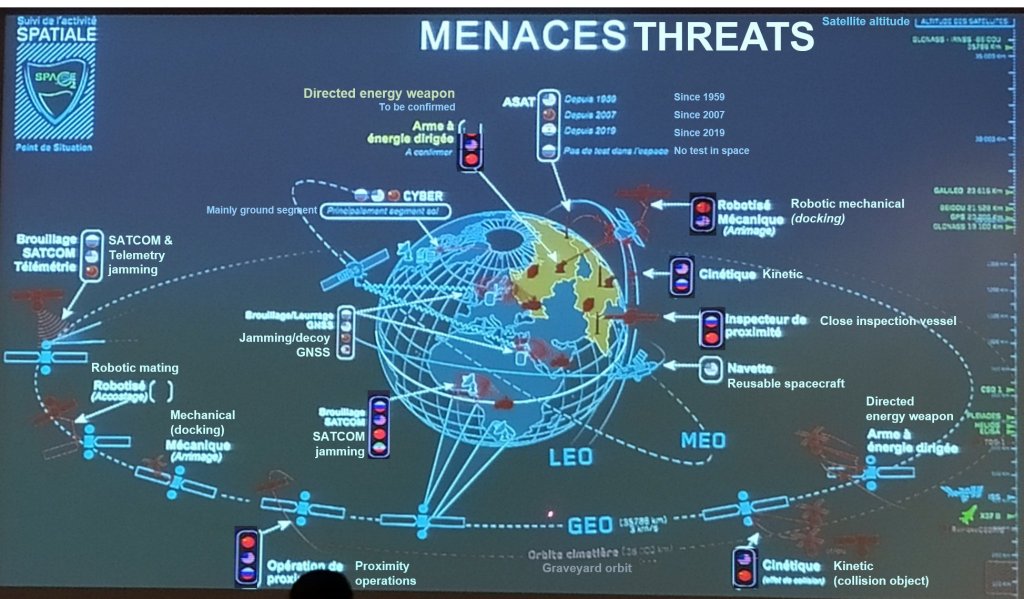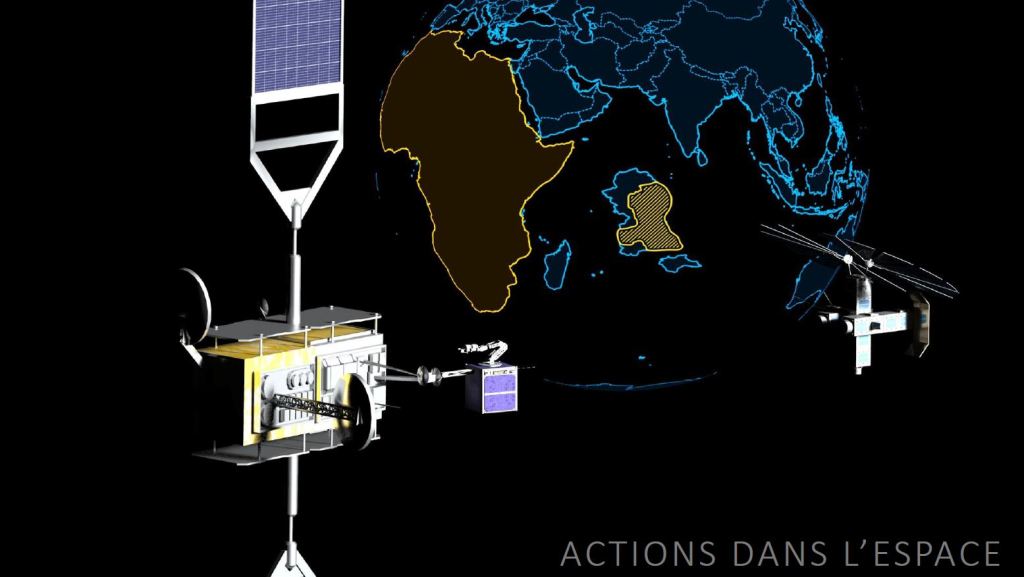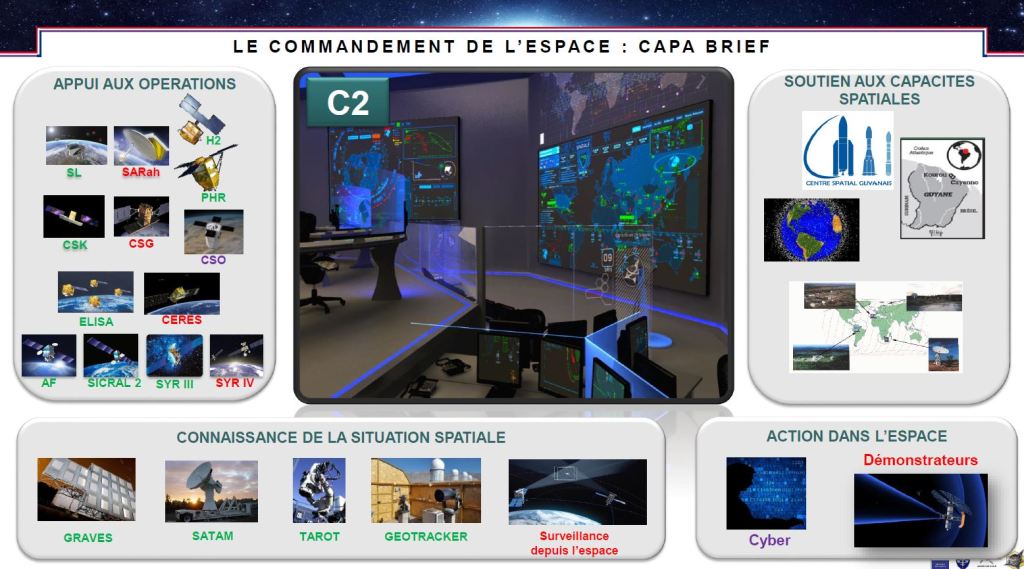France recently published its military space strategy, and the defense think tank Les Jeunes IHEDN organized a conference about it.
The presentation was given by Colonel (Air) Rigal, from Space Command (Commandement de l’Espace, CdE). His responsibilities include ensuring the separate prospective studies of the command form a coherent vision, and directly assisting the general leading the command about military matters.
His divided his speech in three parts: first, the context of what is happening and will happen soon in space. Second, what the French response is. And finally, some open questions and perspectives. He then answered the questions of the audience.
Context
Regarding the context, he summed it up this way: France and other countries are strongly dependent on space, and this dependency is increasing thanks to new technological developments. At the same time, the risks related to space are also increasing.
New technological developments
The major development in recent years is what is commonly called “New Space”. It is embodied in the launch sector by Elon Musk and SpaceX, by the colonel also mentioned Bezos and Blue Origin. On the satellite side, the rise of cubesats and small satellites makes it possible to build constellation of hundred of satellites, such as the Oneweb or Starlink telecommunications constellations.
Interestingly, he linked the birth of New Space in the US back to Reagan’s Strategic Defense Initiative in the 1980s. This project, also nicknamed ‘Star Wars’ by its detractors, consisted in building a space-based ballistic missile shield to protect the USA. He stated that it pushed the USA to think about cheap access to space, due to the enormous number of satellites required. He went on to say that this thinking has endured the various US administrations, with a continuity of policy regard access to space.
He forecasted that after the New Space movement, there would be a second phase, which he called Next Space. The major technological changes it would bring being the spread of distributed architectures, with megaconstellation providing resilient and persistent capabilities.
Further into the future, a third phase called Power Space could emerge, with the use of new in-space energy sources, such as Helium 3 mining on the Moon, and of new launch and propulsion technologies.

Risks
He then went on to outline the risks and challenges presented by space. First of all, he stressed that strategic competition between great powers is back. No longer are they focused on asymmetric conflict with smaller states. Space is destined to be and remain one of the major domains of this competition, because it is so lightly regulated. This only piece of international law that constrains all actors is the Outer Space Treaty of 1967, which prohibits stationing weapons of mass destruction in orbit, and using the celestial bodies for military purposes. Everything else is fair game.
Space is also a domain in which “grey actions” are possible. By this, he meant hostile actions that do not rise up to the standard of an aggression, making it difficult to respond.
Furthermore, space is a transparent domain, in which anybody can see what is happening, but it is hard to keep watch over 100% of it. Besides, due to the return of great power conflict, all the orbits are under various kinds of threats. The situation is made more complex by the problem of space debris: kinetic action in space, or unintentional collisions, create a large number of debris, which can also create other collision, creating even more debris. This chain reaction called the Kessler Syndrome could make whole orbits unusable, especially in low Earth orbit. They make the use of kinetic anti-satellite weapons an impractical proposition.
The French response
Timeline
Space has long been critical to France’s security. Historically, one of its major contributions was giving political authorities a capability to independently assess situation, which is necessary to build strategic autonomy. For instance, space assets, namely the Helios observation satellites, probably helped France convince itself that Irak did not have weapons of mass destruction in 2003, in addition to other sources of intelligence. President Chirac stood up to the US and refused to take part in the second Gulf War, even threatening to veto any US-backed UN resolution legitimizing military intervention.
More recently, the 2017 Defense and Security review was the first to define space as a domain of operation unto itself, and not only supporting the other domains. Following a period of one year of reflection, President Macron announced on 13th July, 2019, the creation of a Space Command, under the responsibility of the Air Force, to replace the previous Joint Space Command.
On 25th July, 2017, Armed Forces minister Parly detailed the French military space strategy. France was the first country to openly describe its ambitions and it military space strategy. The speech generated a lot of talk in foreign ministries around the globe, mainly due to the mention of an “active defense” doctrine to protect French assets.
On 3rd September, 2019, the Space Command was effectively created.
Priorities of the Space Command
The space command reason for being is to ensure France has the liberty of action in and of access to space. Its objectives are structured into three main “pillars”:
– The first is strengthening space’s support to operations. This means the capabilities that space assets provide to operation on Earth. This is currently funded and undergoing, with a new generation of satellite programs becoming operational in the years to come: The CSO optical Earth observation satellites, the first of which has already been launched, are replacing the ageing Helios II satellites. The CERES signal intelligence triplet will take over from the ELISA demonstrator, which will represent a revolution in French electronic intelligence capabilities. The current Syracuse III communication satellites will be replace by a new generation called Syracuse IV some time in the 2020s. All of this might represent a shift from space capabilities being used mainly by political authorities and the highest level of the military, for strategic purposes only, to a much more widespread and operational use among the armed forces down to the tactical level and even to the elementary effectors.
– Space Situational Awareness (SSA). Colonel Rigal stated this is the pillar in which most of the effort remains to be done in the next ten years. The objective is to have the capability to watch over all orbits, to detect and characterize objects: is it a debris, a satellite, a hostile satellite, and armed hostile satellite? Due to the large and increasing number of objects, collection and analysis of information will have to be automated. France wishes to be independent in this domain, but is open to cooperation to augment its own capabilities. Overall, while France already has some SSA assets, there is still an almost full capability to build

– Active defense in space. This is the third and most controversial pillar. It means performing actions to deter aggression against space capabilities and protect them if need be. As the colonel said, “we are forbidding ourselves … the least amount possible”. He also pointed out there has not been any treaty superseding the 1967 Outer Space Treaty because even though there is debate going on in many international forums, ultimately the country cannot agree on a replacement. Thus the international law on space will likely remain very light, with very few constraints. This leads the ministry to want to be able to carry out military action in space, and thus for legal reasons it needs active military service members to perform them. The goal is to act while respecting a « non-aggressive » use of space. Regarding what the active defense capability will be made out of, the Colonel explained France ruled out kinetic ASAT due to the debris they cause. He reminded the audience that minister Parly mentioned small bodyguard satellites designed to watch over and protect space assets, mainly in geostationary orbit.
The three pillars are declined into four types of space-related military operations:
– Space service support (ie launch, satellite commissioning, etc)
– Space support to operations on Earth, which supports the first pillar
– Space Situational Awareness, which supports the second pillar
– Active space defense, which supports the third pillar

To be able to carry out these operations, Space Command needs to be built, which will require a lot of effort. One of the main efforts will be in training its personnel. To do it, the command will rely on the expertise near the city of Toulouse, where it will be located. Toulouse is the heart of the French air and space industry, with dedicated engineering schools such as Supéaro, industrial actors such as Airbus or Thales, and the civilian agency CNES.
France is also counting on cooperation: it has applied to host the NATO center of expertise on space. It already hosts the CASPOA, the center of expertise on Air warfare. Bilateral partnerships are also critical. France has a strong partnership with Germany, Italy, Spain and Belgium: it has built shared observation and communication capabilities with them. The other major partner is the united states, which freely provide SSA data (which still has to be independently verified though), and also the GPS signal. interestingly, the USA are strongly supporting the active defense policy, likely because they are doing the same and do not want to be politically isolated. Finally, India, Japan, Australia and Canada are also important partners in space.
Regarding national and international law, France has written and passed its own law on space operation. This law will have to be updated in particular because of active defense.
Still, nothing will happen without money: the military planning law, written before Space Command was announced, provided 3.6 billion € for space, mostly for the new generation of satellite programs. Minister Parly announced an additional 700 million €, to fund the preparatory work on SSA and active defense. The mid-life update to the planning law is currently being debated within the ministry, and since the overall budget will not increase, fierce competition is going on to decide from which other commands the money and personnel will be taken.
Finally, on the question of personnel, Space Command will see the number of space-related service members strongly increase, from around 220 today, to around 500 in 2025. It will bring all of them under a single chain of command. 90% of them will be in Toulouse, and 10% in Paris. The command will be located within CNES’ campus, next to Airbus and the “City of Space” complex. Contrary to other commands in the forces, Space Command will be both an operational command -in charge of carrying out military operations- and an organic command -in charge of training and equipping units. This is because it has a very small size, so splitting it would make no sense. Another unique feature is that it is both a joint command -for the operations side- under the authority of the joint chief, and an Air Force command – for the organic side- under the authority of the Chief of the Air Staff.
Perspectives & prospective
To conclude, Colonel Rigal mentioned four prospective issues which will have a heavy impact on the future of space
– The first is the use of space as the backbone of the internet, which will become a reality if the megaconstellation projects such as Starlink and Oneweb succeed. Not only would it make space a vital infrastructure for the global society, but the fact that such constellation could be dual-use and carry also military payloads could further complicate things.
– Such large constellations will make today’s Space Traffic Management approach, where everybody do what they want, untenable. There will need to be a mechanism to prevent collisions, even if it is a set of guidelines and not a biding international treaty.
– The strong link between cyber and space will become even stronger with such projects. This link is already acknowledged by the Chinese, who have a common space and cyber command, and by the Japanese, who have a single command for space, cyber and electronic warfare. The link between these three domains is that they are data-heavy, and need significant infrastructure to process data and act on it.
– Finally, an open question remain: how to define an hostile act in space, from a legal point of view? Currently, this question is not currently answered in the command.
Q&A
Q: You mentioned partnerships, could you tell us more about France joining the Combined Space Operations (CSpO) initiative?
A: Sure. You have to understand what CSpO is. Initially, it was a 5 eyes structure, between the US, UK, Australia, New Zealand and Canada. These countries form an intelligence-sharing Anglo-Saxon alliance. France, along with Germany, was invited as an observer in 2016, and joined as a full member in 2020. Germany become on in 2019. The objectives of CSpO are to develop interoperability between the countries, so that their capabilities can be used in joint operations. It is also to create a space doctrine, detailing how to carry out operations in space, to share data, and to build norms of behaviour. Overall, the aim is that we speak a common language.
Q: What about the Moon?
A: The ministry is only interested in near space, up to geostationary orbit, because further orbits have no military impact, and exploration is the concern of the civilian space agency. So it is not part of the military space strategy. However, other countries have a single national space strategy, in which exploration plays a big role. This is the case of China and Japan, which are for instance thinking about Helium 3 mining on the Moon to power fusion reactors.
Q: Do you foresee changes in space-related international law?
A: It is not likely. Even Space Traffic Management, which is a pressing issue because of debris, can create political challenges: one country could try to pass their own STM legislation aimed at pushing competitors out of business, regarding what launch providers are allowed for instance. However the megaconstellations will force some kind of agreement, even if it is only norms of good behaviour and not full treaties.
Q: Regarding active defense, what are our options?
A: We are not considering kinetic ASAT because of the debris they create. Jamming and blinding are a solution but they are hard to do from Earth, especially in the case of the geostationary orbit. Cyber remains the easiest way, but minister Parly in her 25th July speech announced that we could launch small bodyguard satellites and position them around our geostationary assets, to detect and prevent hostile approaches against them.
Q: Regarding STM, SSA and cooperation, how to make sure other European countries do not get all of the funds?
A: Different countries have different priorities. France, for instance, is deeply attached to independent access to space, unlike other countries: we are talking about French self-sufficiency. Other European countries such as Germany and Italy have strong ambitions and budgets in space, and lots of projects, so they have a legitimate role to play in STM/SSA development. Sometimes European governance is a delicate matter, with the European Space Agency and the European Union having different member countries. However, the recently installed European commission has proposed a security budget, and SSA may be part of it. What will happen of this budget remains to be seen.


Reblogged this on The restless technophile.
LikeLike
[…] the more general military space policy changes recognize space as a contested domain and put the focus on developing resilient capabilities. Thus, […]
LikeLike
[…] capabilities. To readers of this site, it will not be news as it has been extensively covered in previous articles. A quick summary is that France has adopted a military space policy which holds space to […]
LikeLike
[…] space defense strategy. After the command was stood up, it started implementing this strategy and shared details on it in 2020 to a wide […]
LikeLike
[…] were putting a lot of effort into defeating these assets. Consequently, France revised its space strategy, with a renewed emphasis put on Space Situational Awareness (SSA), which is the ability to know […]
LikeLike
[…] https://satelliteobservation.net/2020/03/18/french-military-space-strategy/ […]
LikeLike